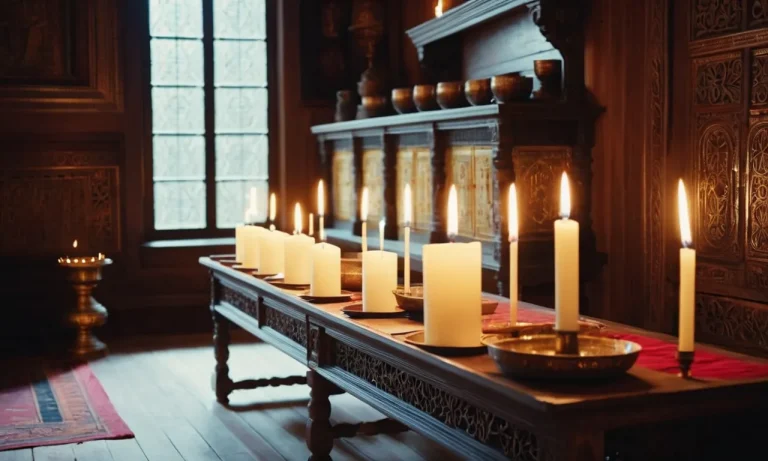The six-pointed star, made up of two intersecting triangles, has held deep spiritual meaning since ancient times. If you’ve ever wondered what the six-pointed star symbolizes, you’ve come to the right place.
In short, the six-pointed star is an ancient symbol that has been used for thousands of years to convey ideas about unity, intersection, harmony and spirituality across different cultures and spiritual traditions.
In this comprehensive guide, we will explore the history, symbolism and spiritual meaning behind the six-pointed star across various cultures and belief systems including Judaism, Hinduism, Christianity and occult traditions.
History and Origins of the Six-Pointed Star Symbol
Early uses in decoration and ornamentation
The six-pointed star shape has been used as a decorative symbol for thousands of years across many cultures and religions. Some of the earliest known uses come from ancient Mesopotamia and Egypt where craftsmen used the design in patterns on pottery, jewelry, and architecture dating back over 4,000 years.
It was likely just used as an aesthetically pleasing shape at first. Similar early appearances have also been found in ancient Persia, prehistoric Indian temples, and even Neolithic European megalithic art.
Appearances in ancient religions and cultures
Over time, the six-pointed star took on more symbolic meaning in a variety of religions and cultures. In Hinduism and Buddhism, it represented perfection and harmony through the union of male and female energies. Ancient Greek mystics saw it as a powerful talisman.
Some Native American tribes used it to symbolize the heart and mind uniting. In medieval Christian art, six-pointed stars were used to symbolize God’s perfection and creation. Interestingly, Muslim mystics also adopted it as a symbol of mystical union with Allah.
Adoption in Judaism, the Star of David
The six-pointed star is most widely recognized as the Star of David, an important symbol in modern Judaism. But when and why did it become such a definitive Jewish emblem? While its origins are unclear, most scholars believe the Star of David started being used as a distinctly Jewish symbol starting in the Middle Ages.
In the 1600s, it began appearing on Jewish synagogues, tombstones, and manuscripts across Europe and the Middle East. By the 1800s, despite some resistance from more traditional rabbis, it had become very widely used to represent Judaism and the Jewish community.
The reason for this long transition to Jewish symbolism stems from an old mystical tradition that the Star of David’s six points represent God’s rule over the universe in all six directions. Today, despite its complex history, it remains the most universally recognized symbol of Judaism and Jewish identity.
Symbolic Meanings of the Six-Pointed Star
Two intersecting triangles representing union of opposites
The six-pointed star, commonly known as the Star of David, is comprised of two intersecting triangles – one pointed up and the other pointed down. This represents the union of complementary opposites (a common theme in mysticism and spiritual symbolism).
The upward triangle symbolizes the spiritual realm or metaphysical energies while the downward triangle represents worldly matters and physical manifestation. Together, they reflect the interconnectedness between Heaven and Earth, mind and body, male and female.
In esoteric schools of thought like Kabbalah, the six-pointed star reflects the harmony achieved by balancing opposing forces. The Jewish philosopher Maimonides saw the symbol as representing the metaphysical concept of the “Perfect Man” – one who integrates both intellect and morality, strength and compassion.
Upward and downward pointing triangles symbolizing ascendance/descendance
Looking at each triangle individually also reveals symbolic meaning. The upward pointing triangle generally represents ascendance, evolution or higher development – whether referring to personal enlightenment, societal progress, or even supernatural forces.
It reflects metaphysical focus, higher purpose and spiritual alignment.
In contrast, the inverted triangle pointing down relates to worldly matters – the descent from the Heavens to Earth, supernatural intervention in human affairs. In ancient traditions, this triangle often represented female life-giving energy manifesting in nature, as opposed to (upward) male energy in the realm of thought and spirit.
Seven points counting the center representing cosmic order
An intriguing aspect of the six-pointed star is that there are actually seven points if you include the center where the triangles intersect. This relates to spiritual concepts across cultures about seven as a number representing completion, cosmic order and sacred geometry as evidenced in nature.
In Kabbalah, the center point reflects Da’at – the invisible, mystical source of wisdom that balances the opposing forces of Chochmah (masculine energy) and Binah (feminine energy). Some say the center point allows spiritual influences to manifest in the physical world.
Regardless of one’s faith, the six-pointed star remains a geometrically unique shape full of mystical symbolism and meaning that transcends religious boundaries. It continues to captivate spiritual seekers and visual artists globally (reference).
Spiritual Significance in Major Religions and Traditions
Judaism – Protection, David’s Shield, Redemption
In Judaism, the six-pointed Star of David symbolizes God’s rule over the universe in all six directions. Known as the “Shield of David”, it offers divine protection against enemies. King David used this symbol on his battle shield as a protector in war.
The six points also represent the six days of creation, and the star emblem decorates Jewish synagogues, cemeteries and artifacts as an iconic symbol of Judaism.
Hinduism – Union of Masculine and Feminine Energies
The upward and downward pointing intersecting triangles of the Star of David symbolize the harmony between masculine and feminine energies in Hindu philosophy. Their union creates stability and integrity in one’s consciousness.
The star is seen as the blueprint for sacral chakra awakening, and some yantra meditation diagrams contain the symbol.
Christianity – Star of Bethlehem, Christ’s Nativity
In Christianity, the Star of Bethlehem announced the coming of the messiah with its bright light guiding the three wise men to witness Christ’s nativity. The six points represent the six days of creation, when God made the heavens and earth and creatures that inhabit it, before resting on the seventh day.
The six points also symbolize the six attributes of God – power, wisdom, majesty, love, mercy and justice.
Occult Traditions – Protection Amulets, Talismans
The hexagram has been used as a protective symbol in occult traditions for thousands of years. Ancient sorcerers and alchemists drew the hexagram in circles to ward off evil spirits before attempting their rituals and spells. The pattern was believed to evoke supernatural power to aid the wearer.
Even today, the Star of David continues to be a popular design for amulets and talismans among modern mystics, psychics and Wiccans.
Modern Applications and Interpretations of the Six-Pointed Star
Use in New Age practices for healing and clearing energy
The six-pointed star, or hexagram, is widely used in New Age energy healing practices. The upward-pointing triangle is seen as representing masculine or Yang energy, while the downward triangle represents feminine or Yin energy (Self Care Haven).
By meditating on the interlocked triangles of masculine and feminine energy within the star, practitioners aim to achieve harmony, balance and healing.
Specific New Age uses of the hexagram in energy work include:
- Placing star of David jewelry or imagery over energy centers (chakras) on the body to clear blockages
- Incorporating the symbol into crystal grid layouts used for energy cleansing in homes or spaces
- Visualizing the star radiating light around a person’s aura or energy field to rebalance and strengthen it
Adoption as a general spiritual symbol representing wisdom, unity
Beyond its roots in Jewish tradition, the six-pointed star is now seen by many as a general spiritual symbol representing higher wisdom, harmony and unity between complementary forces (Learn Religions). This reflects the star’s geometric balance and symmetry.
Interfaith organizations have adopted the hexagram to symbolize the underlying unity of diverse spiritual traditions.
Some modern mystical schools of thought describe the six points as embodying the integration of spiritual qualities like love, wisdom, harmony and abundance. Each quality balances with its “opposite” – for example, wisdom balances love, abundance balances harmony.
Meditating on the star and its integrated, complementary meanings is seen as a path to enlightenment or self-realization of the divine source within.
Incorporation into modern mysticism and occult magic
The hexagram features prominently in ritual magic practiced by some modern-day occultists and mystics. According to the principles of sacred geometry, each side of the star has a length equal to the “golden ratio”.
This links the star to key concepts like the Fibonacci sequence and divine proportion believed to manifest the patterns of creation (GoldenNumber.net).
In magic rituals and spells, the hexagram may be drawn or visualized to represent the intention being manifested. The upward and downward facing triangles aptly capture the formula “as above, so below” – connecting the material realm with higher metaphysical planes.
Common modern magical uses include:
- Casting protective magical circles
- Spellcraft focused on harmony, balance or duality
- Connecting one’s lower self with the Higher Self
With its rich symbology and history, the hexagram continues to fascinate mystics, healers, philosophers and spiritual seekers in the modern age.
Conclusion
The six-pointed star is an ancient symbol that has carried spiritual meaning since the dawn of civilization. Across cultures and faith traditions, it has represented ideas of unity, harmony, ascent and descent, masculinity and femininity – all unified within its elegant geometrical form.
To this day, the six-pointed star continues to hold deep spiritual symbolism, particularly for those in Jewish, Hindu, Christian and esoteric occult traditions. With its intricate symbolic meanings and history spanning thousands of years, this distinctive hexagon-shaped star will likely maintain its spiritual significance for millennia to come.






